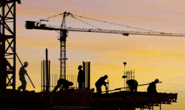Steel Markets

AGC: Construction Spending Rebounds in October
Written by David Schollaert
December 7, 2021
Total construction spending edged higher in October, as gains in public and private project types outmatched decreases in single- and multifamily residential outlays, reported the Associated General Contractors of America (AGC).
Public sector investments would likely rise in the near future as a result of the recently-passed infrastructure bill, according to the AGC, but they cautioned that labor shortages and supply-chain problems were posing significant challenges for the industry.
“It is encouraging to see such a broad-based pickup in spending on nonresidential projects in the latest month,” said Ken Simonson, AGC’s chief economist. “But the construction industry still faces major challenges from workforce shortages and supply-chain bottlenecks.”
Construction spending in October totaled $1.60 trillion at a seasonally adjusted annual rate, 0.2% above the September rate and 8.6% higher than last October. Year-to-date spending through October was 7.5% higher than the same 2020 period.
Among the 16 nonresidential project types the Census Bureau reports on, all but two posted spending increases from September to October. Total public construction spending rose 1.8% for the month, while private nonresidential spending inched up 0.2%. However, for the first 10 months of 2021 combined, nonresidential spending trailed the same year-ago period by 4.7%, with mixed results by type.
Combined private and public spending on electric power and oil and gas projects – the largest nonresidential segment – declined 0.6% for the month and lagged the 2020 year-to-date total by 1.7%. Every other large category saw an increase in October.
Highway and street construction spending increased 2.4% for the month, though the year-to-date total lagged the same 2020 period by 0.8%. Education construction rose 0.2% in October, but trailed the 2020 year-to-date total by 9.2%. Commercial construction – comprising warehouse, retail, and farm structures – was nearly unchanged from September to October, but was 1.9% higher for the first 10 months combined than in January-October 2020.
Residential construction spending declined for the second month in a row, slipping 0.5% month on month. Nevertheless, the year-to-date total for residential spending was 24.2% higher than in the same months of 2020. Spending on new single-family houses decreased 0.8% for the month, but outpaced the 2020 year-to-date total by 25.9%. Multifamily construction spending dipped 0.1% in October, but topped the 2020 year-to-date total by 16.6%.
Spending on many categories of public construction is likely to increase soon as the investments from the bipartisan infrastructure bill begin to flow, said the AGC. They cautioned, however, that the supply-chain challenges and labor shortages were impacting construction schedules and budgets and prompting some owners to delay or cancel projects.
AGC again urged the Biden administration to explore new ways to relieve shipping delays and to invest more in career and technical education programs that serve as a pipeline into construction careers.
“Getting a handle on supply chains and encouraging more people to work in construction will go a long way in helping this industry recover,” said Stephen Sandherr, AGC’s CEO.

David Schollaert
Read more from David SchollaertLatest in Steel Markets

Steel buyer spirits tempered by soft spot market conditions
Steel sheet buyers report feeling bogged down by the ongoing stresses of stagnant demand, news fatigue, tariff negotiations or implementation timelines, and persistent macroeconomic uncertainty.

Hot-rolled coil buyers continue seeking certainty
Steel market participants contend that buyers will remain in “wait-and-see" mode until some market stability is restored.

Latin American steel advocates warn on cheap import flood
Subsidized Chinese steel imports and cheap steel products from Association of Southeast Asian Nations (ASEAN) entering Latin American (LATAM) are threatening the region's steel market.

CRU: Steel prices fall amid global demand weakness
The forceful headwinds bearing down on steel markets across the globe have created demand challenges and sent prices southward. The US, however, challenged the global trend.

Hot-rolled price hikes garner mixed reactions from the market
Several steel market sources say they were blindsided when mills increased spot prices for hot-rolled coils this week.
